NIKON NUVIS V User Manual

Instruction Manual (Pages 2–37) Bedienungsanleitung (Seiten 38–73) Manuel d’utilisation (Pages 74–109) Manual de instrucciones (Páginas 110–145)
E
G
F
S

Foreword
E
Thank you for purchasing the Nikon Nuvis V camera.
Your new Nikon camera employs the Advanced Photo System (IX240 system). The symbol T*appears on all Advanced Photo System (APS) format cameras.
Be sure to read this instruction manual thoroughly before use, and keep it close at hand.
*The Advanced Photo System symbol is a trademark of all IX240 products.
Take some trial shots.
Before taking important pictures, be sure to take a few trial shots first to familiarize yourself with the camera and all of its features.
2
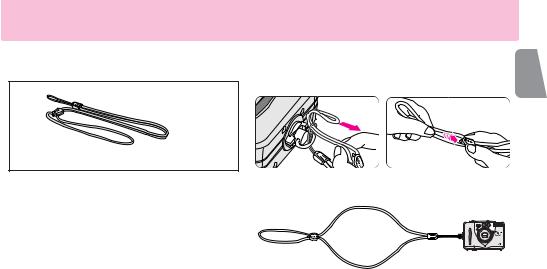
Accessories |
|
|
Check that you have the item shown below before using |
E |
|
your camera. |
||
Attaching the strap |
||
|
Neck strap |
|
Optional accessories |
Attach the strap by inserting it through the strap slot and adjust the |
length using the lug on the strap as shown. |
|
•Camera case CS-L20 |
|
(Remote control unit can be stored inside pocket.) |
|
•Remote control unit (- P. 25) |
Put your head |
|
through this loop. |
3

Your Nikon camera features:
■ Choice of three print types (C, H, P), which can be mixed on the same |
P. 14 |
E
|
C-type (classic) |
H-type (wide-vision) |
P-type |
|
Aspect ratio = 2 : 3 |
Aspect ratio = 9 : 16 |
Aspect |
|
■ The 3x power zoom lens covers the range of focal length from 22.5mm to |
||
|
■ Title imprinting (ex. “HOLIDAY” or “CONGRATULATIONS”) on the back of |
||
|
■ The number of desired prints (1 to 9) can |
|
|
|
■ When the available light is low or the subject is backlit, the camera |
||
|
■ Remote-controlled operation (optional) is possible. |
P. 25 |
|
|
■ MRC (Mid-Roll Change) allows you to switch film |
. |
|
|
camera automatically advances the film to the frame |
|
|
|
■ Photographing subjects as close as 0.45m (1.5 ft.) |
P. 26 |
|
4 |
■ The lens cover automatically closes when the camera |
|
|
28
 P. 27
P. 27  P. 21
P. 21
reloaded, the

Contents |
|
Foreword ................................................................................... |
2 |
Accessories ...................................................................................... |
3 |
Your Nikon camera features .............................................................. |
4 |
Camera parts ................................................................................ |
6-7 |
LCD panel indications ....................................................................... |
7 |
Tips on using the Nuvis V ................................................................ |
8 |
Getting started |
|
Installing the battery/Checking battery power ................................... |
9 |
Loading the film ....................................................................... |
10-11 |
IX240 film cartridge ....................................................................... |
11 |
Data recording function .................................................................. |
12 |
Basic operation |
|
Holding the camera properly .......................................................... |
13 |
Shutter release operation ............................................................... |
13 |
Viewfinder indications .................................................................... |
14 |
Selecting a print type ...................................................................... |
14 |
Adjusting diopter ............................................................................ |
15 |
Zooming ........................................................................................ |
15 |
Focusing and shooting .............................................................. |
16-17 |
Difficult-to-focus subjects ............................................................... |
17 |
Removing the film .................................................................... |
17-18 |
Take the exposed film cartridge to a photo lab ............................... |
18 |
|
To rewind the film in mid-roll ........................................................ |
19 |
E |
Advanced operation |
|
|
How to use focus lock .................................................................... |
20 |
|
Selecting the flash mode ................................................................ |
21 |
|
Auto flash photography .................................................................. |
21 |
|
Flash cancel mode ......................................................................... |
22 |
|
Anytime flash mode .................................................................. |
22-23 |
|
Slow sync flash mode ..................................................................... |
23 |
|
Red-eye reduction mode ................................................................ |
24 |
|
Remote control photography (optional) .......................................... |
25 |
|
Self-timer operation ....................................................................... |
26 |
|
Close-up shooting ......................................................................... |
26 |
|
Specifying the number of desired prints ......................................... |
27 |
|
Title recording function ............................................................ |
28-29 |
|
Setting the date and time .......................................................... |
30-31 |
|
Battery power saving function ........................................................ |
31 |
|
Other information |
|
|
Troubleshooting ....................................................................... |
32-33 |
|
Specifications ........................................................................... |
34-35 |
|
For safe handling of the camera (WARNING/CAUTION) ........... |
36-37 |
5 |
|
|
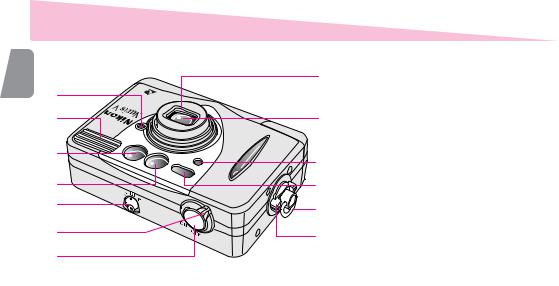
Camera parts
E
1
2
3
4
5
6
7
8
9
10
11
12
13
1Auto exposure metering window
2Flash (-P. 21)
3AF assist illuminator/Red-eye reduction lamp (-P. 24)
4Viewfinder window (-P. 14)
5CHP selector (-P. 14)
6Power switch (-P. 9)
7Shutter release button (-P. 13)
8Lens cover (-P. 9)
9Lens
10Remote control reception sensor (-P. 25)
11Autofocus window
12Neck strap slot (-P. 3)
13Cartridge lock release lever (-P. 10)
14Diopter adjustment lever (-P. 15)
15Orange LED/Green LED (-P. 14)
16Viewfinder eyepiece (-P. 14)
17@C/Red-eye reduction/Self-timer indicator/ Remote control button (-PP. 24-26)
18Mid-roll rewind button (-P. 19)
19J/Flash mode button (-PP. 21-23)
6
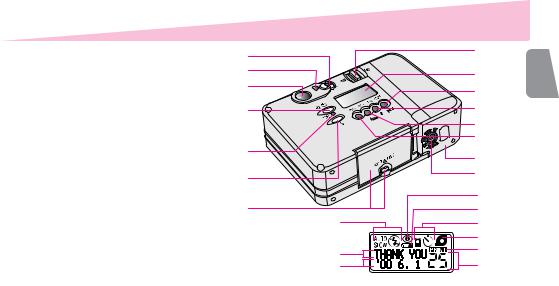
20Battery chamber lid/Battery chamber lid button (-P. 9)
21Zoom lever (-P. 15)
22LCD panel
23ADJUST/ 
 button (-PP. 27, 28, 30)
button (-PP. 27, 28, 30)
24SEL/ button (-PP. 28, 30, 31)
button (-PP. 28, 30, 31)
25TITLE/  button (-PP. 27-29)
button (-PP. 27-29)
26DATE button (-P. 12)
27Cartridge chamber cover (-P. 10)
28Tripod socket (-P. 25)
LCD panel indications
1Flash mode indicator (-PP. 21-23)
2Title recording indicator (-PP. 28-29)
3Date and time/Number of desired
prints recording indicator (-PP. 12, 27)
4Red-eye reduction indicator (-P. 24)
5Low battery power indicator (-P. 9)
6Remote control/Self-timer indicator (-PP. 25, 26)
7Cartridge indicator (-P. 11)
8Data recording indicator (-P. 12)
9Frame counter (-P. 11)
14
15
16
17
18
19
20
|
21 |
|
|
22 |
E |
|
23 |
|
|
24 |
|
|
25 |
|
|
26 |
|
|
27 |
|
|
28 |
|
|
4 |
|
1 |
5 |
|
6 |
|
|
|
7 |
|
2 |
8 |
|
3 |
9 |
7 |
LCD panel |
|

Tips on using the Nuvis V
E |
Camera care tips |
•Turn the camera off when not in use. This prevents accidental |
|
release of the shutter and resulting battery drain. |
|
|
•The Nuvis V is not a waterproof and therefore should not be |
|
exposed to rain or saltwater. If water gets on the camera, wipe it |
|
off with a dry cloth immediately. |
|
•Do not subject the camera to high temperatures such as those |
|
encountered near a heater or stove or the interior of a car during |
|
summer. |
|
•Store the camera in a cool, dry, clean place. Do not expose it to |
|
chemicals such as camphor or naphthalene. Using a desiccant |
|
during storage is recommended. |
|
•Firing the flash repeatedly makes the battery and camera hot. |
|
Allow enough time for them to cool off before taking pictures |
|
again. |
|
•Do not drop the camera or hit it against a hard surface. |
•Use a dry, soft cotton cloth or commercially available blower brush or lens cleaner to remove dirt and smudges.
•When storing the camera for a long time, remove the battery. Also once a month, insert a battery and fire the flash several times to reform its capacitor.
Notes on battery
•Be sure to check battery power when taking important pictures. Carry spare batteries when traveling abroad.
•Battery power becomes less when the temperature drops below 0°C (32°F). When taking pictures at low temperatures, keep the battery warm. Battery power will recover when the temperature goes back to normal.
Notes on IX240 film cartridge
•Carrying spare IX240 film cartridges is recommended when traveling abroad where the IX240 film cartridges may not be available.
Nikon cannot be held responsible for malfunctions caused by using the Nuvis V in ways not specified in this manual.
8
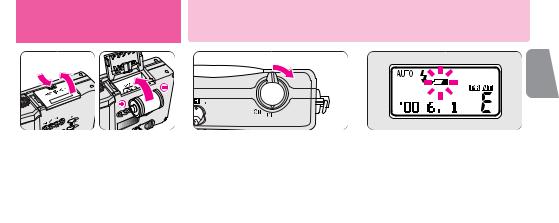
Getting started
1Install the battery.
▼Push the battery chamber lid button and slide open the battery chamber lid.
▼Install one 3V lithium battery CR2 inside the battery chamber.
▼Close the battery chamber lid.
•Reset the date and time, when the battery is replaced. (- P. 30)
Installing the battery/Checking battery power
E
3 Check battery power.
•If “b” blinks or nothing appears on the LCD panel, the battery is exhausted and needs to be replaced.
•If a low battery power indicator “b”
does not appear, battery power is full.
automatically. (- P. 31)
9
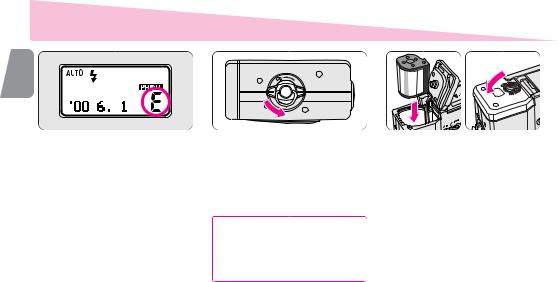
Loading the film
E
1Check that the letter “´ ”is visible on the LCD panel.
•If the number of frames appears on the LCD panel, a partially exposed cartridge is already loaded.
•If the letter “´” and the cartridge indicator “  ” appear on the LCD panel, a cartridge that is fully exposed is loaded and should be removed. (- P. 17)
” appear on the LCD panel, a cartridge that is fully exposed is loaded and should be removed. (- P. 17)
10
2Turn the cartridge lock release lever in the direction of the arrow to open the cartridge chamber cover.
The cartridge chamber cover locks automatically after loading. Do not try to open the cover until film rewinding is complete and the motor inside the camera stops.
3Insert a film cartridge in the cartridge chamber and close the cover.
•Use only IX240 film cartridge. (Regular 35mm film cannot be used.)
•Check that the VEI (Visual Exposure Indication) shows “○” (unexposed) or “;” (partially exposed) before loading. (- P. 11)
•Close the cartridge chamber cover until it clicks shut.
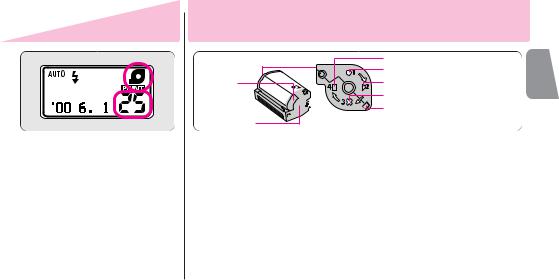
4Check that the available number of frames and “ ” appear on the LCD panel.
” appear on the LCD panel.
•If the number of frames does not appear, reload the film.
•“´” blinks if a fully exposed film cartridge (the VEI shows “<”) or a processed film cartridge (“=”) is inserted.
IX240 film cartridge
Data disk
Lightlock door 

 Lightlock door drive
Lightlock door drive  Cartridge spool
Cartridge spool
|
= Processed film inside the cartridge* |
E |
|
:Unexposed film* |
|
|
;Partially exposed film* |
|
|
||
|
<Fully exposed but unprocessed film* |
|
|
|
|
|
Irreversible Processed Indicator |
|
*Visual Exposure Indication (VEI)
•Available film cartridges: 40-exposure, 25-exposure, and 15-exposure films.
•IX240 film cartridges do not have a film leader. The film is automatically pulled out and set inside the camera.
•The VEI (Visual Exposure Indicator) shows the four states of the film.
Notes on handling IX240 film cartridges
•Do not touch, disassemble or apply strong physical shock to the Data disk, Lightlock door or Cartridge spool.
•Do not break the Irreversible Processed Indicator. If broken, consult your nearest photo lab.
•Do not subject the film to direct sunlight, high temperatures near a heater or stove, dust and humidity, or a
strong magnetic field.
11
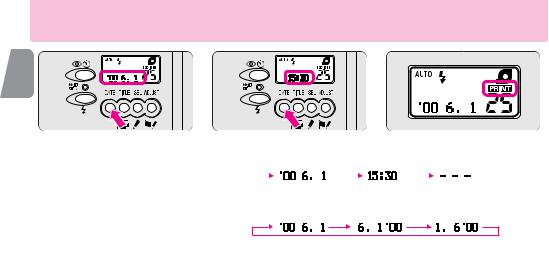
Data recording function
E
Set your preferable display mode.
▼ Press the DATE button.
•The “Year” section is displayed and printed in two digits and the “time” is in 24-hour cycle.
•“- - -” appears when “No recording” mode is selected.
•When adjusting the date and time, refer to “Setting the date and time” on page 30.
12
•Press the DATE button to select one of three displays. Each time the button is pressed, the display changes in the order indicated:
|
Year/Month/Day |
Hour/Minute |
No recording |
|||
|
|
|
|
|
|
|
•Press and hold the DATE button for more than 2 sec. while “- - -” is displayed. The display changes in the order indicated:
Year/Month/Day Month/Day/Year Day/Month/Year
•When shooting while “Å”appeared on the LCD panel, data on the LCD will be recorded. No data is recorded when the “- - -” mode is selected.
•Ask your photo lab that displays an “Authorized Photo Lab Mark” sign for the location of the recorded data.
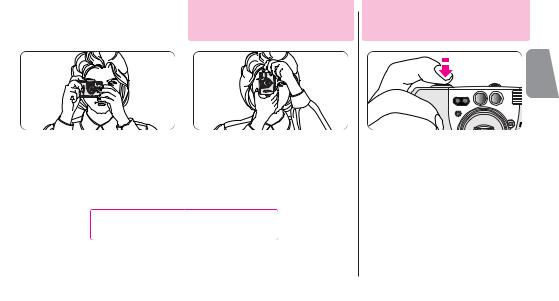
Basic operation |
Holding the camera |
properly |
•When holding the camera vertically, make sure that the flash is on top as shown.
flash, or autofocus fingers or hair.
Shutter release operation
E
Lightly press the shutter release button to achieve focus and exposure and the green LED will light up. While the shutter release button is depressed lightly, the focus is locked. (- P. 20)
Press the shutter release button all the way to release the shutter.
13
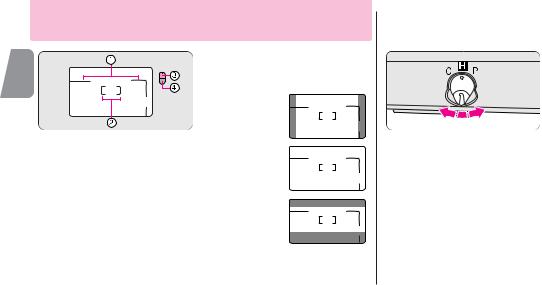
Viewfinder indications
E
1Parallax compensation marks
For close-up shooting in C and H print types at a distance of approx. 1m to 0.45m (3.3 ft to 1.5 ft.) (- P. 26)
2Autofocus frame mark
Center this mark on the subject.
3Orange LED
If lit continuously: Flash is ready to fire. If blinking: Flash is being charged and not ready to fire.
4Green LED
If lit continuously: Correct focus has been achieved. If blinking: Correct focus has not been achieved or the shooting distance is
14 closer than approx. 0.45m (1.5 ft.)
H-type
(wide-vision) Aspect ratio = 9 : 16
P-type
(panorama) Aspect ratio = 1 : 3
(Parallax compensation marks not usable.)
Selecting a print type
Use the CHP selector to select your desired print type before shooting.
•You can select any one of three print types (C, H or P) by switching the CHP selector at any time while film is loaded. (- P. 4) Available picture area differs depending on the print type selected.
•You can also change the type of print when ordering extra prints at the photo lab.
CAUTION!
To prevent possible injury to your eye, hold the camera away from your face when you operate the CHP selector.
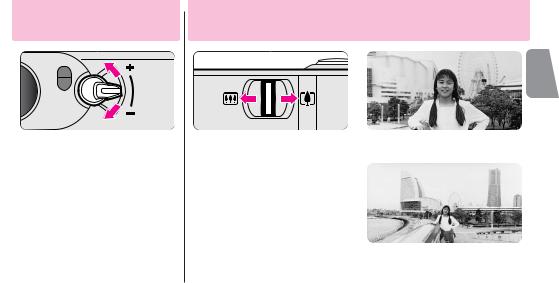
Adjusting diopter
•Turn the diopter adjustment lever until the autofocus frame mark appears sharp in the viewfinder.
CAUTION!
As you look into the viewfinder and operate the diopter adjustment lever, make sure not to injure your eye with your finger or fingernail during adjustment.
Zooming
E
Look through the viewfinder and compose the picture by moving the zoom lever.
▼When the desired image size has been achieved, remove your
finger from the zoom lever.
•When the camera is not in use for approx. 2 min., the lens automatically retracts to the  (wideangle) position.
(wideangle) position.
(- P. 31)
Move the zoom lever in the 
 direction (66mm) to extend the lens for taking telephoto pictures.
direction (66mm) to extend the lens for taking telephoto pictures.
Move the zoom lever in the  direction (22.5mm) to retract the lens for taking wide-angle pictures.
direction (22.5mm) to retract the lens for taking wide-angle pictures.
15
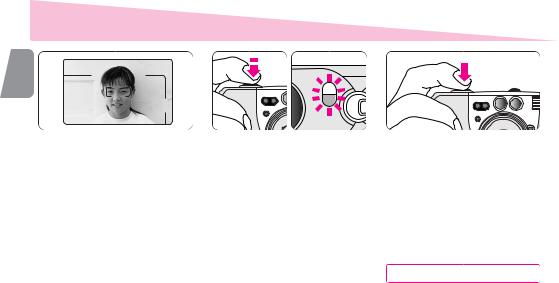
Focusing and shooting
E
1Compose the picture.
•Center the autofocus frame mark on the subject.
•To ensure sharp pictures, make sure your subject is at least approx. 0.45m (1.5 ft.) away from the camera.
•When taking subjects within the range of approx. 0.45 to 1m (1.5 to 3.3 ft.), compose the picture within the parallax compensation marks. (-P. 26)
16
2Focus on the subject.
▼Lightly press the shutter release button.
•The green LED lights up when focusing is complete.
If the green LED blinks slowly: the shutter is locked, because the shooting distance is less than 0.45m (1.5 ft.).
If the green LED blinks quickly: the subject is difficult to focus (-P. 17). In this case, the shutter can be released, resulting in out-of-focus pictures.
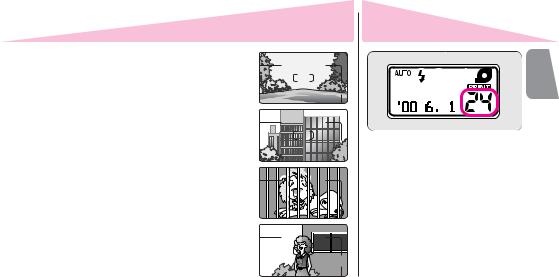
Difficult-to-focus subjects:
The following subjects may be too difficult to focus. In these cases, use focus lock (- P. 20) by focusing on another subject equidistant from the camera.
A.Low-contrast subjects such as the blue sky or highly reflective surfaces like shiny cars or water.
B.Subjects with continuous and repeated patterns.
C.Both near and far subjects present at the same time within the autofocus frame mark.
D.Strongly backlit subjects or those having a bright shiny background.
A
B









C
D

Removing the film
E
on the LCD panel, rewind the film midway through the roll. (- P. 19)
17
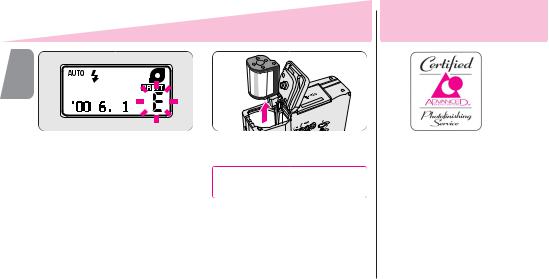
Removing the film
E
“´” blinks.
•If film rewind stops midway through the roll due to a dead battery, it resumes automatically as soon as the battery is replaced.
18
3Open the cartridge chamber cover and remove the film.
Do not open the cartridge chamber cover until “´” starts blinking.
•When opening the cartridge chamber cover, make sure that the camera bottom faces up, or the cartridge may fall out.
Take the exposed film cartridge to a photo lab.
•We recommend bringing your film cartridge to a photo lab that displays an “Authorized Photo Lab Mark” sign above for processing and printing.
•Your negatives are returned inside the cartridge for easy storage.
•Index prints (small images of each frame exposed on the roll of film) are supplied with the negatives.
•For more information, consult your photo lab.
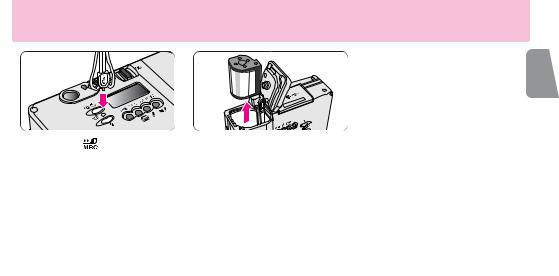
To rewind the film in mid-roll
2Remove the film.
▼ Open the cartridge chamber cover.
▼ Remove the film.
▼ Check if the VEI (Visual Exposure Indication) shows ;.
•If the VEI shows ;(partially exposed film), the camera automatically advances the film to the frame immediately after the last exposed frame when the film is reloaded.
Notes on MRC |
E |
|
(Mid-Roll Change) |
||
•A partially exposed film can be |
||
|
||
switched at any time among |
|
|
cameras that feature MRC, such as |
|
|
Nikon Pronea 600i/6i, Nuvis 160i, |
|
|
Nuvis S and Pronea S cameras. |
|
|
•When reloading a partially exposed |
|
|
film, avoid an environment subject |
|
|
to strong electric or electromagnetic |
|
|
fields (for example, near a TV, |
|
|
personal computer, audio speaker, |
|
|
or an electric fan). |
|
19

Advanced operation
E
1Compose the picture.
•When the main subject is outside the autofocus frame mark “ ”, the area behind the subject will be in focus.
20
How to use focus lock
the center of the frame:
2Center the autofocus frame mark on the main subject.
▼Lightly press the shutter release button.
•Make sure that the green LED lights up.
3Recompose the picture and shoot.
▼While depressing the shutter release button lightly, recompose the picture.
▼Then depress the shutter release button all the way.
•As long as the shutter release button is pressed lightly, focus is locked.
•Do not change the camera-to-subject distance while lightly pressed the shutter release button.

Selecting the flash mode
Press theJbutton until the desired flash mode indicator appears.
•For details, see the reference page of each flash mode.
→AUTOJ Auto flash (-P. 21)
↓
# Flash -P. 22)cancel (
↓
J Anytime flash (-P. 22)
↓
† Auto flash with slow sync
(-P. 23)
•When the camera power is turned off, the flash mode reverts to auto flash.
Auto flash photography
available light is low or the subject is backlit.
E
1Turn the camera on.
“• AUTOJ”appears on the LCD panel. Auto flash mode is automatically activated.
•The camera senses when the available light is low or the subject is backlit and automatically fires the flash.
•When “#” appears on the LCD panel, the flash does not fire. In this case, no oragne LED lights up.
2Check that the orange and green LEDs come on, then shoot.
•Before shooting with flash, make sure the subject is within the flash shooting distance range. Refer to the following guide (ISO 200).
 (22.5mm): approx. 0.45 to 4.2m (1.5 to 13.8 ft.)
(22.5mm): approx. 0.45 to 4.2m (1.5 to 13.8 ft.) 
 (66mm) : approx. 0.45 to 2.8m (1.5 to 9.2 ft.)
(66mm) : approx. 0.45 to 2.8m (1.5 to 9.2 ft.)
•If the orange LED is blinking, the flash is |
|
recycling and the shutter is locked. Lightly |
|
press the shutter release button again after |
|
approx. 8 sec. and wait for the orange LED |
|
to light up before shooting. |
21 |
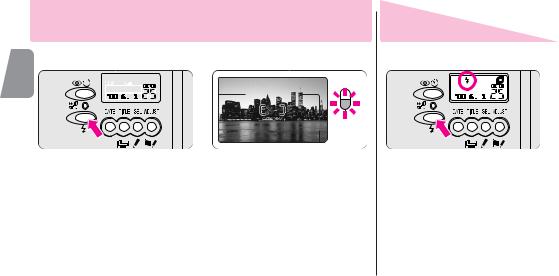
Flash cancel mode
Use this mode where flash photography is lighting effect in night scenes.
E

1Press the J button until “#” appears on the LCD
panel.
•Since slow shutter speeds are usually selected in this mode, use a tripod to prevent camera shake.
2Composeshoot. the picture and
▼Lightly press the shutter release button.
▼Make sure the green LED lights up, then depress the shutter release button all the way to take the picture.
Anytime flash mode
Use this mode to fire the flash intention
1Press the J button until “J” appears on the LCD panel.
22
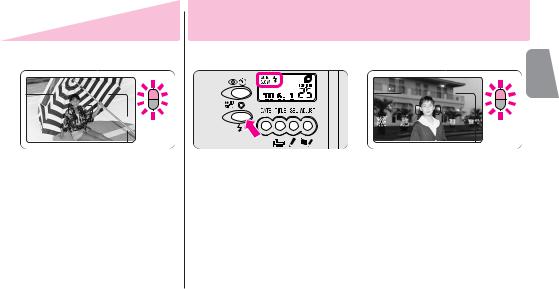
ally regardless of the available light.
2Compose the picture and shoot.
▼Lightly press the shutter release button.
▼Make sure the orange and green LEDs light up, then depress the shutter release button all the
way to take the picture.
•If the orange LED is blinking, lightly press the shutter release button again after approx. 8 sec. and wait for the orange LED to light up before shooting.
Slow sync flash mode
Use this mode to obtain the correct exposure for both the main subject
and background in low-light situations or at night.
E
1Press the J button until “†”appears on the LCD panel.
•Since slow shutter speeds are usually selected in this mode, use a tripod to prevent camera shake.
•When the subject is bright, “#” appears on the LCD panel and flash does not fire. In this case, no oragne LED lights up.
2Compose the picture and shoot.
▼Lightly press the shutter release button.
▼Make sure the orange and green LEDs light up, then depress the shutter release button all the way to
take the picture.
•If the orange LED is blinking, lightly press |
|
the shutter release button again after |
|
approx. 8 sec. and wait for the orange |
|
LED to light up before shooting. |
23 |
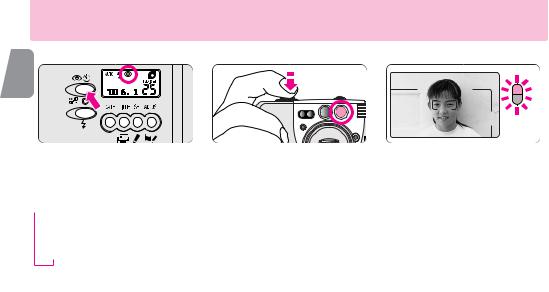
Red-eye reduction mode
In flash photography, the subject’s eyes may sometimes appear bright red. To reduce the “red-eye” effect, use this mode.
E
→
24
2Compose the picture and lightly press the shutter release button.
•Because the red-eye reduction lamp lights up for a second before the flash fires, be careful not to move the camera or let the subject move until the flash fires.
•The red-eye reduction mode is not recommended when shooting fastmoving subjects.
3Check that the orange and green LEDs light up before shooting.
•If the orange LED is blinking, lightly press the shutter release button again after approx. 8 sec. and wait for the orange LED to light up before shooting.
•To cancel the red-eye reduction mode, press the @Cbutton until “@”disappears from the LCD panel. This mode cannot be canceled by turning the power off.
•Red-eye reduction and flash cancel modes can be set together, but in this case red-eye reduction cannot be performed.
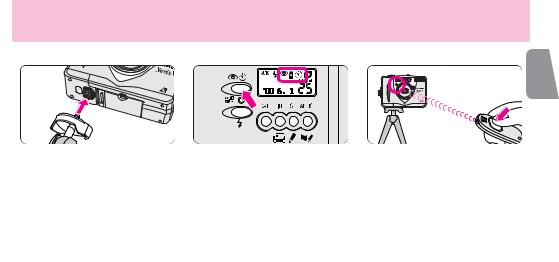
Remote control photography (optional)
For releasing the shutter remotely:
E
1Place the camera on a tripod or a secure flat surface.
•Remote control extends up to approx. 5m (16.4 ft.) while facing the camera. If the camera-to-subject distance is more than 5m (16.4 ft.) away, use the selftimer mode. (-P. 26)
•If the reception sensor on the camera is exposed to direct sunlight or other strong light, the remote controller will not operate properly.
2Press the @Cbutton until “@SC”appears on the LCD panel.
•Remote control will be automatically canceled if not used for more than approx. 2 minutes or the camera is turned off. That means that within 2 minutes after taking the last shots, you can still continue to shoot remotely.
3Compose the picture and shoot.
▼Aim the remote control unit at the camera and press the shutter release button on the unit.
•The red-eye reduction lamp lights up for approx. 2 sec. before the shutter is released.
•If the shutter cannot be released with the remote control, change the battery inside the remote control unit. (The usable life of the battery is approx. 10 years.) Visit an authorized Nikon
dealer or service center to change it.
25
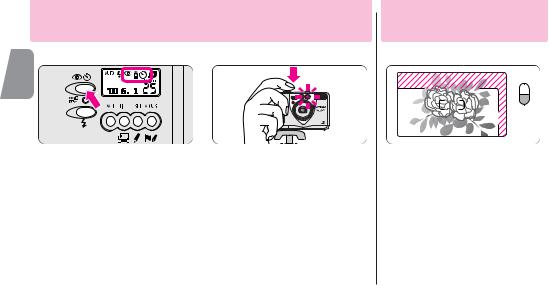
Self-timer operation
When you want to include yourself in the picture:
E
1Press the @C button until “@SC”appears on the LCD panel.
•Self-timer operation will be automatically canceled if not used more than approx.
2 minutes or the camera is turned off. •Placing the camera on a tripod is
recommended.
26
2Compose the picture and depress the shutter release button all the way.
•The red-eye reduction lamp blinks for 8 sec., then lights up for 2 sec. before the shutter is released.
•Self-timer operation is canceled after shooting.
•To cancel self-timer operation, turn the camera off.
Close-up shooting
For taking subjects such as close-ups of flowers:
•When taking subjects within the range of approx. 1m to 0.45m (3.3 ft. to 1.5 ft.), compose the picture within the parallax compensation marks. (The parallax compensation marks cannot be used in P print type) The area  as shown above will be cut off in the final print.
as shown above will be cut off in the final print.
•When the subject is closer than approx. 0.45m (1.5 ft.), the green LED blinks slowly and the shutter is locked.
•If the subject is very close, the green LED blinks quickly and the shutter can be released, resulting in out-of-focus pictures.

Specifying the number of desired prints
The number of desired prints (1 to 9) can be specified frame by frame.
E
1Set the number of desired prints before shooting.
▼Press the  button for more than 3 seconds until “P-1” appears.
button for more than 3 seconds until “P-1” appears.
•The number of desired prints (1 to 9) can be specified frame by frame.
•Be sure to cancel the title recording function when specifying the number of desired prints.(- P. 29)
•“P-1” is displayed when the language code is set to other than JPN (Japanese). (- P. 28)
2Setprints.the number of desired
▼ Press the ADJUST button to set the desired number of prints.
•Each time the ADJUST button is |
|
pressed, the number changes in |
|
increments of one from 1 to 9. |
|
•The specified number is canceled after |
|
shooting. |
|
•To cancel the number before shooting, |
|
set the number to “P-1”. |
27 |
|
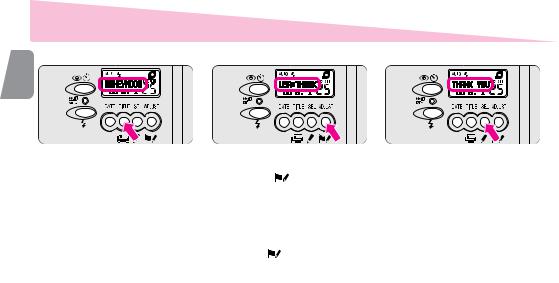
Title recording function
For imprinting a title on the back of pictures:
E
2Set the language.
|
|
▼ Press the |
button until the |
|
|
preferred language appears |
|
|
|
on the LCD panel. |
|
|
|
•For example, if [USA] appears on the |
|
|
|
LCD panel, the language is American |
|
|
|
English. |
|
|
|
•Pressing the |
button continuously |
|
be recorded when a picture is taken. |
for more than 2 sec. changes the |
|
28 |
language quickly. |
|
|
|
|
||
3Set a title.
▼Press the  button until the preferred title appears on the LCD panel.
button until the preferred title appears on the LCD panel.
•Pressing the  button continuously for more than 2 sec. changes the title quickly.
button continuously for more than 2 sec. changes the title quickly.
•The title set scrolls on the LCD panel and the first 9 letters are displayed after the scrolling stops.
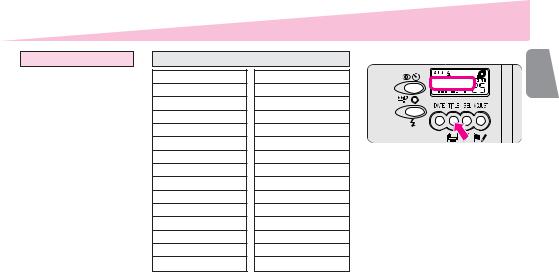
Language provided
Code |
Language |
DEN |
Danish |
FIN |
Finnish |
FRA |
French |
GER |
German |
ITA |
Italian |
JPN |
Japanese |
NOR |
Norwegian |
POR |
Portuguese |
ESP |
Spanish |
SWE |
Swedish |
GBR |
British English |
USA |
American English |
|
|
Titles provided for British English
HONEYMOON
WEDDING
HANUKKAH
GRADUATION
FAMILY
PARTY
HOLIDAY
ANNIVERSARY OF MARRIAGE
FRIENDS
SCHOOL EVENT
TRIP
I LOVE YOU
THANK YOU
SEASON’S GREETINGS
HAPPY BIRTHDAY
CONGRATULATIONS
MERRY CHRISTMAS
FESTIVAL
FIRST DAY OF SCHOOL
HAPPY NEW YEAR
REUNION
FATHER’ S DAY
MOTHER’ S DAY
BAPTISM
ST. VALENTINE’ S DAY
GOOD FRIDAY
EASTER MONDAY
HAPPY EASTER
ST. GEORGE’S DAY
MAY DAY HOLIDAY
E
For titles in other language, see the attached “List of Imprinted User Title”. |
29 |
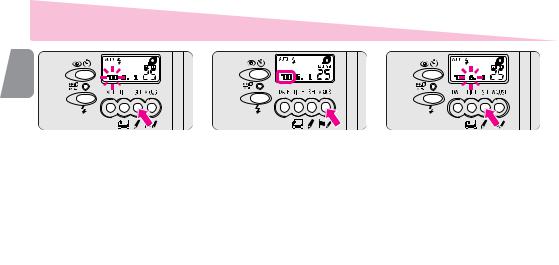
Setting the date and time
E
1Entering the setting mode
▼Press the SEL button for more than 2 seconds.
•The “year” section starts blinking. •Be sure to cancel the title recording
function when setting the date and time.
2Setting the “year”
▼Press the ADJUST button to set the correct year.
•Each time the ADJUST button is pressed, the number changes in increments of one.
•Pressing the ADJUST button continuously for more than 2 sec. changes the number quickly.
3Setting the “month”
▼Press the SEL button. The “month” section starts blinking.
▼Press the ADJUST button to set the correct month.
▼Press the SEL button.
•Repeat procedures 2 and 3 to set the day, hour and minute.
30
